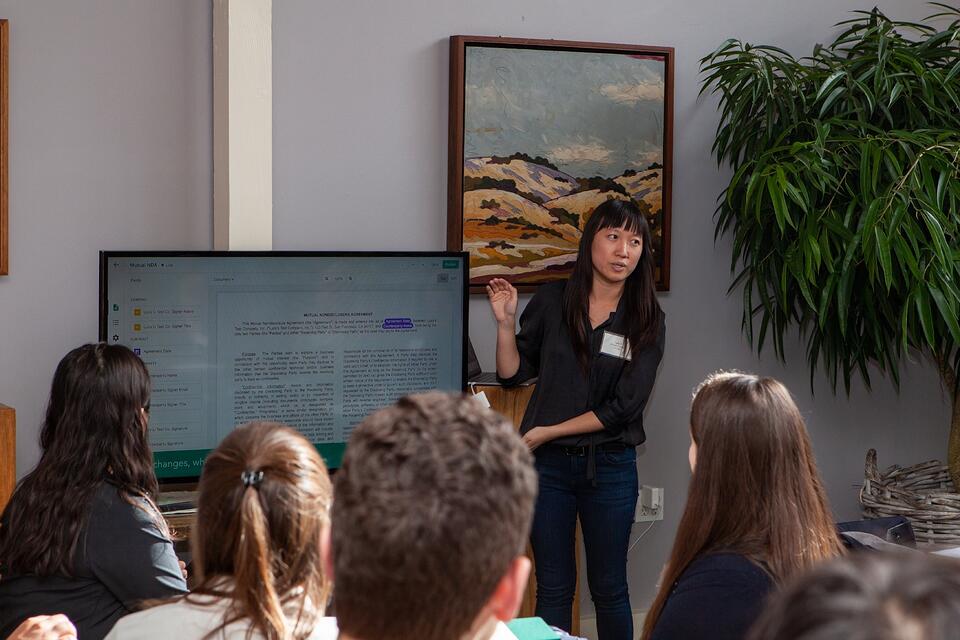Lucy Li is a Product Lead at Ironclad. A Carnegie Mellon-educated engineer, she led the front-end mobile web development of Salesforce’s early tablet and phone product before joining Ironclad in 2015. She was the creative force behind many of Ironclad’s core features, like red-line previewing and complex approvals. Most recently, she lead development of our most recent major product release, called Blueprint.
Blueprint is our answer to the clunky workflow-building tools in the market today. It lets legal teams design and implement contract workflows on their own in a highly intuitive, Microsoft-Word-like interface, without writing a single line of code. I sat down with Lucy to chat about:
- what Blueprint is, and why we think it will be a game-changer for legal teams
- what design and engineering challenges her team faced as they built Blueprint, and how they overcame them
- what’s next in the Ironclad product roadmap
What is Blueprint?
Blueprint is our self-service workflow builder. It helps legal teams automate their routine contract tasks without outside help. It’s also walk-up usable, meaning it doesn’t require any coding or training. You just upload your documents, then tag and define them as if you’re still in Microsoft Word.
Until now, we’ve focused on building a powerful platform for automating and managing contract processes. But, while the platform is very powerful, there’s been a bottleneck: many workflow building tasks still require a Legal Engineer, an implementation manager who can make requested code changes. We wanted to empower legal teams to build their own custom workflows. And we wanted to make it dead simple.
With Blueprint, legal teams don’t need to relay a workflow request to a Legal Engineer and wait for them to implement it. Instead, they can implement it on their own in a matter of hours using a point-and-click interface. And, once the contract workflow has been configured, contracts are processed with the full power of the Ironclad platform, meaning approvals are automated, contract metadata is searchable, and metrics are automatically collected over time.
How will Blueprint affect the Ironclad customer experience?
Until now, Ironclad’s customers have relied on our Legal Engineers to help set up their workflows, or automated business processes. Blueprint is the next step in Ironclad’s mission to give legal teams the tools they need to “own” and optimize their business process.
Here’s how we think about it: legal teams provide services to the rest of the company, often in a business-critical capacity, so they’re used to being held accountable for everything. The problem is that they’ve had accountability without also having the tools to do things like automatically find compliance risks and process contracts. Ironclad’s changed that by putting all contract information in one place.
Blueprint builds on the existing Ironclad foundation by giving legal teams access to the underlying templates and “rules” governing each contract type. At the end of the day, every company is unique and has its own regulatory obligations and priorities. Now, when regulations or priorities change, legal teams can use Blueprint to update their Ironclad templates and workflows with a few clicks. They “own” more of the workflow design process.
Now, a question for product-oriented builders: How did you go about designing Blueprint?
Designing Blueprint was a challenge for everyone on the product team. We looked at other workflow builders, but we didn’t feel they properly balanced power and ease, which is what we wanted to do with Blueprint.
We had to be willing to fail quickly and make course corrections rather than being stubborn about the solution we wanted to implement. A critical part of our choices came from user feedback. We did a lot of user interviews, because that feedback loop is critical. The key to product success and adoption is meeting users where they are, as opposed to forcing them to change their behaviors.
To give you an example, we realized early on that Microsoft Word-like capabilities would be essential. The reason for this is that lawyers and legal teams are used to firing up Microsoft Word whenever they need to work on a contract. So, we dedicated a lot of engineering resources to making sure Blueprint had document-editing capabilities, even though it’s a workflow creation tool.
So when users open up Blueprint, they’re prompted to upload their existing contract template. Then, they can highlight contract text and tag different contract fields (signers and companies, for example) with different rules. Keeping the process document-centric has helped keep the product intuitive, and I think it will pay dividends when it comes to user adoption.

What were some of the technical challenges of building Blueprint?
I mentioned that we wanted Blueprint users to feel like they were manipulating a regular Word document rather than learning a new tool. We said to ourselves, “How can we make sure that a lawyer using Blueprint feels like they already have all the skills they need to succeed with this tool?”
It turns out that, to keep the workflow document-centric, we had to make sure that our tool parsed and rendered DOCX (Microsoft Word Open XML Format Document) files consistently across a range of edge cases. Once you start working with the DOCX data structure and specifications, you encounter a ton of complexity–in large part because DOCX represents documents as a very abstract tree, which is a common data structure, but then you have to think about how to model and format tables and other contract-related inputs in that framework. Another issue was that the DOCX specification isn’t always internally consistent, meaning Microsoft doesn’t always follow its own rules, which required a bit of work to clean up.
So modeling everything was not always intuitive, but the payoff is that the Blueprint user gets an interface that feels very familiar, even if everything under the hood is different.
What’s next for Blueprint?
We’re really excited to get Blueprint off the ground because we think that our users will be able to do things with it that we haven’t even anticipated. That said, currently Blueprint is most useful for simple contracts, like NDAs or simple purchase orders. In the next couple of months, we will be building out all of the conditionality aspects of contracts. For example, changing approval requirements depending on contract value. If your contract size is above a certain threshold, maybe you need to get your CFO’s approval.
In the next year, we want to get smart about clauses. Over time, we want to let lawyers choose between different pre-approved clause options in contracts. Let’s say your company has a standard liability clause for typical customers, and a more robust liability clause for special cases. If both clauses have been reviewed and approved by Legal, they should be interchangeable within an Ironclad template.
Our goal will stay the same, though. We always want to help legal teams become their own system architects and build things for the rest of the company.
For more perspectives on Product at Ironclad, check out our previous interviews with Jason Li, VP of Engineering, and Cai GoGwilt, CTO. To work with us, visit our Careers page.
Ironclad is not a law firm, and this post does not constitute or contain legal advice. To evaluate the accuracy, sufficiency, or reliability of the ideas and guidance reflected here, or the applicability of these materials to your business, you should consult with a licensed attorney. Use of and access to any of the resources contained within Ironclad’s site do not create an attorney-client relationship between the user and Ironclad.




